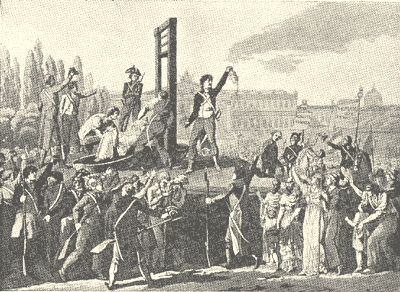|
|||
|
Philatelia.Net / French revolution / Plots / The directory «Plots»Law of the Suspect. The Reign of TerrorThe Law of Suspects is a term which is used to refer to an enactment passed on 17 September 1793 during the course of the French Revolution. It allowed for the creation of revolutionary tribunals to try those who were suspected of treason against the Republic and to punish those convicted with death. The corollary of this was that both enforcement and justice subsequently became synonymous with revolutionary governance. The law called for a general roundup of all suspects; it was a deeply comprehensive list, for example: those who, by their conduct, associations, comments, or writings have shown themselves partisans of tyranny or federalism and enemies of liberty [..] The Reign of Terror (5 September 1793, to 28 July 1794) (the latter is date 10 Thermidor, year II of the French Revolutionary Calendar), also known simply as The Terror, was a period of violence that occurred after the onset of the French Revolution, incited by conflict between rival political factions, the Girondins and the Jacobins, and marked by mass executions of "enemies of the revolution." The death toll ranged in the tens of thousands, with 16,594 executed by guillotine (2,639 in Paris), and another 25,000 in summary executions across France. The guillotine (called the "National Razor") became the symbol of the revolutionary cause, strengthened by a string of executions: Marie Antoinette, the Girondins, Philippe Égalité (Louis Philippe II, Duke of Orléans) and Madame Roland, as well as many others, such as pioneering chemist Antoine Lavoisier, lost their lives under its blade. During 1794, revolutionary France was beset with conspiracies by internal and foreign enemies. Within France, the revolution was opposed by the French nobility, which had lost its inherited privileges. The Roman Catholic Church was generally against the Revolution, which had turned the clergy into employees of the state and required they take an oath of loyalty to the nation (through the Civil Constitution of the Clergy). In addition, the First French Republic was engaged in a series of wars with neighboring powers intent on crushing the revolution to prevent its spread. The extension of civil war and the advance of foreign armies on national territory produced a political crisis and increased the rivalry between the Girondins and the more radical Jacobins. The latter were eventually grouped in the parliamentary faction called the Mountain, and they had the support of the Parisian population. The French government established the Committee of Public Safety, which took its final form on 6 September 1793 in order to suppress internal counter-revolutionary activities and raise additional French military forces. Through the Revolutionary Tribunal, the Terror's leaders exercised broad dictatorial powers and used them to instigate mass executions and political purges. The repression accelerated in June and July 1794, a period called "la Grande Terreur" (the Great Terror), and ended in the coup of 9 Thermidor Year II (27 July 1794), leading to the Thermidorian Reaction, in which several protagonists of the Reign of Terror were executed, including Saint-Just and Robespierre. Comoren Islands, 1989, Dr. Guillotin and Guillotine France, 1984, Monument of Girondins of Republic Jersey, 1983, Incident in the French Revolution Monaco, 1997, Honore III Advertising: |
|||
© 2003-2025 Dmitry Karasyuk. Idea, preparation, drawing up
|

